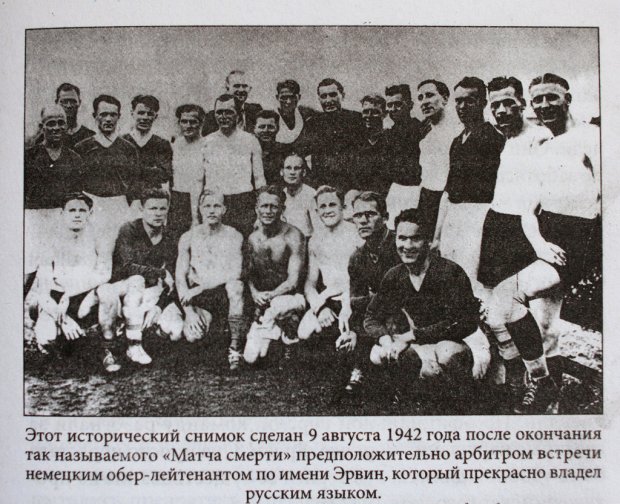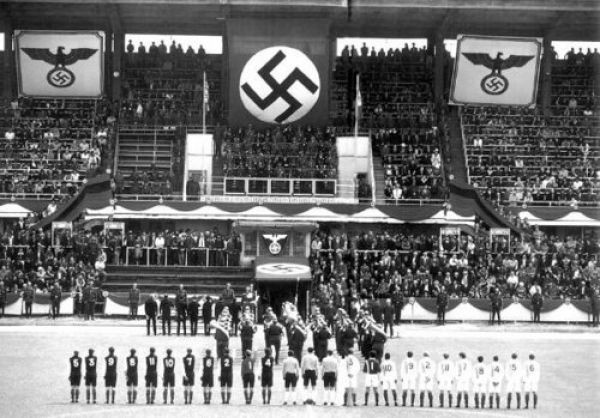
With the World cup well on its way it is time to go back into darker history of football .
Although as a Dutchman it aches me to admit that the Germans generally put up a good team for the tournament, there is however a black mark in the German football history.
KIEV, Ukraine — There are few striking features about Start Stadium except its disrepair. Wooden planks in the grandstand, like neglected teeth, are mostly loose or missing. Behind the tiny seating area, though, a sturdy column rises and supports a statue. It depicts a muscular, naked man heroically kicking a soccer ball into the beak of a trampled eagle.

On the 9th of August 1942, a group of men who worked at Kiev’s Bakery #3 took on the might of the Nazi Luftwaffe team and triumphed. The game was dubbed the “Death Match”. It was a match that went down in legend and folklore. It was a match that was used for Soviet propaganda. It was a match that provided the inspiration for the 1981 film Escape to Victory. It was a match where the events surrounding the game are still being discussed and debated. It had come about because of the remarkable feats of F.C. Start.
On the 19th of September 1941 the Nazis successfully invaded and captured Kiev. A few days after they took over the city, the Nazis slaughtered over 33,000 Jews at the ravine of Babi Yar.

In their attempts to keep the local population under control the Nazi rulers decided to introduce a series of football matches in June 1942. It was part of an effort to distract and pacify the populace with a sense of “normality.” Little did they know that a group of former Dynamo and Lokomotiv Kiev players who worked at a bakery would turn into a symbol of resistance for the people of Kiev.
The formation of F.C. Start effectively began with Nikolai Trusevich. Trusevich was the goalkeeper of Dynamo Kiev before the outbreak of World War II. He enlisted in the army to defend Kiev but soon became a prisoner of war and was held in the Darnitsa camp after the Nazi’s captured the city. Trusevich was eventually released, after signing papers pledging loyalty to the new regime (not that he had much choice considering the alternative), and returned to Kiev.
On August 6, 1942 FC Start played the German team Flakelf. There was an estimated 2,000 spectators in attendance, with each spectator paying a total of five rubles to attend. Zenit Stadium was lined with SS soldiers and police dogs as an attempt to intimidate the Start players.

(I am not sure if this is an actual picture or from the movie which was made in 2012)
The Flakelf team consisted of German soldiers who manned antiaircraft guns around Kiev. FC Start dominated the first game by defeating the Germans 5-1. The German team would demand a rematch. The “Death Match” or second match took place on 9 August 1942 at the Kiev city stadium against the German team Flakelf, made up of air defense artillery football players.

With an audience of 2000,the teams met again three days later, in the later so-called “Death Match”. The poster informed that Flakelf had a “strengthened” team but did not reveal any names. But it named 14 Start players, amongst them Lev Gundarev, Georgi Timofeyev and Olexander Tkachenko, Ukrainian policemen under German command.

The score was 5–3 in favour of Start. Only the first half of the match is documented: The Germans opened the score, then Ivan Kuzmenko and Makar Honcharenko two times marked the 3–1 score for half time. After the match a German took a photograph of both teams showing a relaxed atmosphere. Some days later he offered a copy to former Lokomotiv player Volodymyr Balakin.This photograph was never published in Soviet times.
Afterwards the winners drank a glass of self-made vodka and met at a party in the evening.
There were stories that in the aftermath of the match the players of F.C. Start were rounded up and executed. That wasn’t the case though as the team played one more game a week after the infamous “Death match,” thrashing Rukh 8:0.
On the 18th of August 1942 the Gestapo arrived at Bakery #3 and read out a list of names who were required for questioning. The names were of the players of F.C. Start. The Gestapo wanted to prove that the players were agents of the NKVD, the secret police, and knew that the organization had links to Dynamo Kiev prior to the war. Apparently a picture of Nikolai Korotkykh in an NKVD uniform was discovered and he was tortured to death. The story goes that his sister had turned him in after being interrogated by the Nazis.
The remaining members of the team were sent to a concentration camp at Syrets. It was there, six months after they had been arrested, that Alexei Klimenko, Ivan Kuzmenko and Nikolai Trusevich met their fate. The commander of the concentration camp, Paul Radomski, had ordered the prisoners of the camp to line-up and decreed that every third one would be shot. There are differing reasons given for his decision to exact punishment, ranging from revenge for attacks by Soviet partisans to retribution for prisoner disobedience. No matter what, they were three pillars of the F.C. Start side were felled. Trusevich, it was said, was wearing the goalkeeping top he wore for F.C. Start in the final moments of his life.
Makar Goncharenko, Mikhail Sviridovsky and Feodor Tyutchev, who were in Kiev as part of the work squad, took their opportunity to flee fearing that they would be killed if they returned to Syrets.
The reports give several reasons for the execution:
- A conflict concerning the dog of the camp commandor Paul Radomski: Some prisoners were said to have beaten it with a shovel in the camp kitchen. On this situation one of the prisoners had attacked an SS soldier.

- Punishment for the escape of some prisoners.
- Disobiedience of prisoners who were ordered to hang other prisoners who tried to flee from the camp.
- A sabotage act of partisans on a tank repair facility
After the fall of the Nazis the Soviet government initially played down the story of F.C Start with the exploits of the team only being recognized and broadly told in the late 1950s. The regime soon came to realize the propaganda value of using the legend of F.C. Start to further their ideological cause. From then on the Soviet government used the story of F.C. Start for their own purposes. They promoted the myth that a number of the team were immediately shot after the game and died for their ideology and ideals. Indeed, when Goncharenko was discussing the aftermath of game in 1985 he claimed that Trusevich’s last words were “long live Stalin, long live Soviet Sport.” Again, there are differing accounts of exactly what words, if any, Trusevic uttered. Goncharenko may have felt obliged to give the regime’s version of events..
After the publication of a report in a German newspaper repeating the Soviet version a case about the “Death Match” was opened by the prosecution office of Hamburg in July 1974.As Soviet authorities did not collaborate on the case, it was closed in March 1976. In 2002 the Ukrainian authorities informed Hamburg about their new investigation. So the case was reopened, but finally closed by the investigation commission in February 2005. The commission was not able to find any connections between the game and the execution of people who participated in it, nor any person responsible for the executions being still alive. Radomski had been killed on 14 March 1945.
Either way one can not help but wonder if these men were killed because of the match.
Many may never have heard of this story while some may have forgotten it but the city of Kyiv shall forever remember this incredibly brave group of eleven men who stood for everything the city believed in, the men who held this city together through one year of the war, the men who defeated Germany, the men who expressed themselves through the sport they loved, the men who wanted to free Ukraine!
Two movies were inspired on the event. Although the 1981 one movie “Escape to Victory”directed by John Huston is only very loosely based on the match, the only similarities it has is a match between Germans and Non Germans during WWII. In the movie the Germans play allied POWs.

In 2012 the Russian movie “Match” ,which is actually based on the event , caused quite some controversy in the Ukraine.
Regulators said the film could incite aggressive fans just weeks before Ukraine hosted several games played by Germany’s national team during the 2012 European Championship from June 8-July 1.
‘There always are people – hooligans – who use football to spill out their aggression and some of those people may be influenced by (the film),’ said political analyst Volodymyr Fesenko.
In the Dynamo Kiev Stadium in Kiev a monument has been erected depicting some of the players reputedly executed by the Nazis.

Whether the players were eventually executed or not I don’t really know for certain, but given the fact that the Germans were defeated twice must have been a blow to the Nazi propaganda machine and therefore it would not surprise me in the slightest that the men were killed because of this.

Donation
I am passionate about my site and I know you all like reading my blogs. I have been doing this at no cost and will continue to do so. All I ask is for a voluntary donation of $2, however if you are not in a position to do so I can fully understand, maybe next time then. Thank you. To donate click on the credit/debit card icon of the card you will use. If you want to donate more then $2 just add a higher number in the box left from the PayPal link. Many thanks.
$2.00


Reblogged this on History of Sorts.
LikeLike